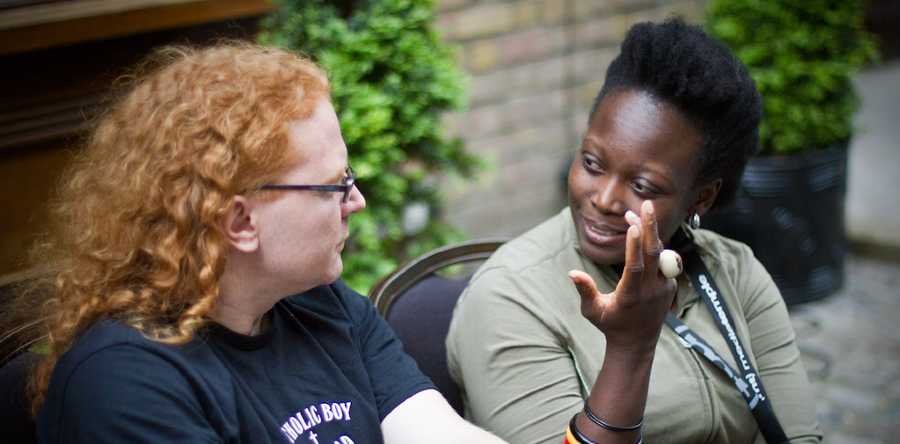Types of Narrators and How to Choose
Let's talk about different types of narrators and how to choose the right one for your story!
 photo credit: Jason Lander @ Flickr
photo credit: Jason Lander @ FlickrFirst-person narrators
A first-person narrator is normally a character in the story who uses "I" to describe events from their own perspective.
Some advantages of using a first-person narrator...
- Immediacy: First-person narration pulls readers into the story. Readers feel like they're hearing the story firsthand from someone who was actually there.
- Voice: You can write the story in your narrator's speaking style. Your narrator might have an interesting or entertaining style that adds to the reader's experience.
- Character development: By listening to the way the narrator talks and their description of events, readers get to know the narrator as a person.
Here's the same event, written in the voices of different first-person narrators.
EXAMPLE 1: I screamed as the ghost glided toward me.
EXAMPLE 2: When that ghost came out of the wall, you better believe I started screaming my friggin head off.
EXAMPLE 3: After twenty-plus years as a war correspondent, I thought I'd grown nearly impervious to horror, but something about that translucent white shape broke through my carefully-cultivated numbness. I heard whimpering that I was surprised to realize was coming from my own mouth.
EXAMPLE 4: Mommy always says there's no such thing as ghosts, but a white thing's coming out of the wall, and I yell until my throat hurts.
One advantage of first-person narration is the close relationship that can develop between readers and the narrator. The narrator can start to feel like a friend who's been chatting with, and confiding in, the reader.
Disadvantages of first-person narration...
First-person narration limits your storytelling to the perspective of one character, which can be a disadvantage for some stories.
- It might be harder to give readers all of the information they need.
- Your narrator's perspective might not be the most dramatic or interesting one for certain parts of the story.
- Your narrator's voice could also be limiting. For example, a child narrator might not have the vocabulary or understanding to communicate certain ideas.
Barbara Kingsolver's novel THE POISONWOOD BIBLE uses different first-person narrators for different chapters. This is a possible workaround if you want to write in the first person but include a variety of perspectives.
In THE POISONWOOD BIBLE, each chapter is labelled with the name of its narrator to prevent readers from getting confused.
 photo credit: OuiShare @ Flickr
photo credit: OuiShare @ FlickrUnreliable narrators
An "unreliable narrator" is a type of first-person narrator whose version of events isn't completely trustworthy.
An unreliable narrator might be biased or deluded about some aspect of the story they're telling. Or they could be deliberately trying to fool or manipulate the reader.
You can use an unreliable narrator...
- to add layers of psychological complexity to your story
- for humor (e.g., a narrator whose lack of self-awareness is amusing)
- to create a mystery or suspense (i.e., the reader doesn't know what to believe)
- to create a plot twist (e.g., at the end of the story, readers discover that certain things were not as they'd seemed).
Third-person narrators
 photo credit: K V Soon @ Flickr
photo credit: K V Soon @ FlickrA third-person narrator is an authorial voice that tells the story using "he", "she", "they", etc.
Even in third-person narration, there's often a particular character whose perspective is used to show a scene or a story. This is called "third-person limited" narration.
For example, the Harry Potter novels are generally told from Harry's point of view, but not in his voice (Harry is called "he" and "him", not "I").
By limiting your storytelling to one character's perspective and experience, you get some of the advantages of first-person narration. Readers identify strongly with your viewpoint character. They start to feel like they ARE that character, experiencing the story's events firsthand.
You can even write parts of the story in the "voice" of your viewpoint character's thoughts.
EXAMPLE: Jenna couldn't believe that her idiot parents were actually telling people about the ghost. Like she didn't have enough problems already! Now everyone at school would know she lived in a haunted house.
You might write the whole story from the same character's perspective, or you might have different sections narrated from the points of view of different characters.
If you decide to switch points of view, just be careful not to confuse the reader.
In novels with multiple points of view, authors often divide points of view into separate chapters, so that there's a clear transition.
Another kind of third-person narration, called "third-person omniscient", doesn't limit the storytelling to a particular perspective.
Instead, an omniscient narrator is all-knowing. They can describe a scene from a bird's-eye view, or dip in and out of different characters' experiences.
Omnisicient narration is an advanced technique that is difficult to do well. If you're a beginning writer, you might have more success using first-person or third-person limited narration.
Advantages of third-person narration...
- Flexibility. It gives you the most options to tell the story from multiple perspectives.
- Authorial style. Instead of writing in the voice of a character, you can write in your own voice, which might be more poetic, sophisticated, or nuanced than the way your character would naturally speak.
Disadvantages...
You lose some of the intimacy that you can get with first-person narration, as well as losing the chance to write fully in the character's voice.
Second-person narrators
 photo credit: Marc Thiele @ Flickr
photo credit: Marc Thiele @ FlickrSecond-person narration tells a story using "you", as if the events are happening to the reader.
EXAMPLE: You watch the ghost fade back into the wall. You can hardly believe what you just saw.
Second-person narration is not common in fiction. The effect can be interesting, but it can also feel gimmicky if it's not done well.
Choosing your narrator
Here are also some questions that can help you choose the right narrator for your story.
- How deeply do you want readers to get to know and identify with your main character? If you want to create a lot of intimacy, first-person narration might be a good choice.
- Do you want to write your story from a single perspective, or from multiple points of view? For multiple viewpoints, a third-person narrator might be a more natural choice.
- Do you want to play with an unreliable narrator? Then the first-person will likely work better.
- Is there a certain character who is part of all of the main events of the story? Then you might choose this character as a first-person narrator -- or choose third-person limited narration from this character's perspective.
- Does your main character have an interesting and engaging voice that readers would enjoy in a first-person narrator?
- Do you "hear" the story in your head in particular character's voice? Does writing in a certain character's voice feel natural or fun? That character might make a great first-person narrator.
If you're not sure what kind of narration to use in a story, the best thing is to experiment. Try writing the same scene in different ways and see which version works best.
Types of Narrators -Exercises
 photo credit: Puchie Darcy @ Flickr
photo credit: Puchie Darcy @ FlickrHere are some exercises to help you practice writing with different types of narrators:
1) Describe a crime in the voice of an unreliable first-person narrator. The narrator is the person who committed the crime, but they are lying to the reader about that. Drop in hints that that your narrator can't be trusted.
2) Think of a celebrity with a distinct speaking style. Borrow this person's voice for the first-person narrator of a story. Option 1: Use this person's voice to rewrite a story you've already written. Option 2: Use this person's voice to narrator a story about a parent-teacher conference that goes horribly wrong.
3) Character A and Character B go on a first date. Character A thinks the date went great. Character B thinks it was awful. Write the scene in third-person limited from Character A's perspective. Then write the same scene in third-person limited from Character B's perspective.
Types of Narrators - Next Steps
Join our writer's email group to get writing tips and ideas sent to you every week. It's free!
You also might like:
- Online Course: Through Your Character's Eyes
- Online Course: Mastering Dialogue